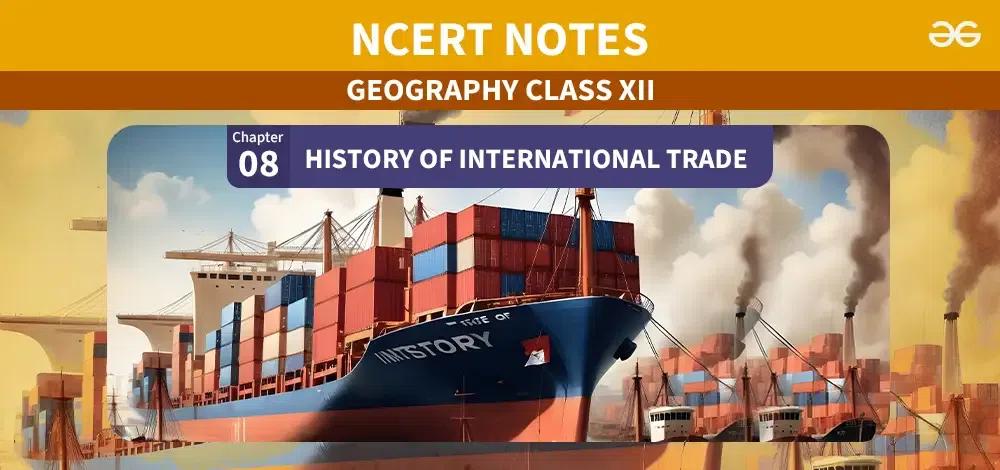Class 12 Geography Notes Chapter 8 History of International Trade
Last Updated :
24 Apr, 2024
The history of international trade spans millennia, reflecting the intricate interplay of economic, political, and social forces that have shaped global commerce. From ancient trade routes like the Silk Route to the emergence of modern trade networks, this journey has been marked by innovation, exploration, and exploitation.
Understanding the evolution of international trade offers valuable insights into the complexities and dynamics of contemporary global economies.

Class 12 Geography Notes Chapter 8 History of International Trade
History of International Trade: An Overview
The history of international trade is as follows:
Ancient Trade Practices
In ancient times, trade was primarily localized due to the risks associated with long-distance transportation. Communities focused their resources on necessities, with luxury items like jewelry and costly clothing being reserved for the wealthy elite. This period saw limited trade in high-value commodities, marking the early stages of international commerce.
The Silk Route: A Path of Exchange
The Silk Route stands out as an early example of long-distance trade, spanning approximately 6,000 kilometers and connecting Rome to China. Traders along this route facilitated the exchange of Chinese silk, Roman wool, precious metals, and other coveted goods from intermediate points in India, Persia, and Central Asia, showcasing the interconnectedness of ancient civilizations through commerce.
European Commerce and Exploration
Following the disintegration of the Roman Empire, European commerce experienced significant growth during the twelfth and thirteenth centuries. The development of ocean-going warships facilitated trade between Europe and Asia, while the discovery of the Americas opened up new avenues for exploration and trade routes. This period marked the beginning of European colonialism and the expansion of global trade networks.
Emergence of Slave Trade
The fifteenth century witnessed the emergence of a dark chapter in international trade with the advent of slave trade. European powers such as the Portuguese, Dutch, Spaniards, and British engaged in the forcible capture and transportation of African natives to the newly discovered Americas for labor in plantations. This exploitative trade persisted for over two hundred years until its abolition in Denmark (1792), Great Britain (1807), and the United States (1808), reflecting evolving moral and ethical standards.
Industrial Revolution and Trade Dynamics
The Industrial Revolution brought about significant shifts in trade dynamics, as the demand for raw materials like grains, meat, and wool expanded alongside the growth of manufacturing industries. However, the monetary value of primary products declined relative to manufactured goods, leading industrialized nations to import raw materials and export value-added finished products to non-industrialized nations, perpetuating a cycle of economic dependency.
Modern Era and Trade Regulations
The latter half of the nineteenth century witnessed a transition where regions producing primary goods lost significance, and industrialized nations became each other’s primary trading partners. However, the outbreak of World Wars I and II prompted countries to impose trade taxes and quantitative restrictions for the first time, disrupting global trade flows. In the post-war period, organizations like the General Agreement on Tariffs and Trade (later becoming the World Trade Organization) played a crucial role in reducing tariff barriers and promoting international cooperation in trade.
Conclusion
The history of international trade is a narrative of evolution, characterized by the interplay of economic, political, and social forces over millennia. From ancient trade routes like the Silk Route to the exploitative practices of slave trade and the industrial transformations of the modern era, international trade has shaped global economies and societies in profound ways. As nations navigate the complexities of contemporary trade relations, understanding the historical trajectory of international commerce provides valuable insights into current challenges and opportunities for global cooperation and economic development.
Class 12 Geography Notes Chapter 8 History of International Trade-FAQs
What were the primary motivations behind ancient international trade routes like the Silk Route?
Ancient trade routes like the Silk Route facilitated the exchange of goods and ideas between distant civilizations. Motivations for trade included access to valuable commodities, cultural exchange, and the pursuit of wealth and power.
How did European colonialism impact international trade during the fifteenth to nineteenth centuries?
European colonial powers engaged in the exploitation of natural resources and labor through practices like slave trade, significantly altering global trade dynamics. Colonies served as sources of raw materials for European industries, driving economic growth but also perpetuating inequalities.
What role did the Industrial Revolution play in reshaping international trade dynamics?
The Industrial Revolution transformed international trade by increasing the demand for raw materials and fueling the growth of manufacturing industries. Industrialized nations began exporting manufactured goods to non-industrialized regions while importing raw materials, establishing patterns of economic dependency.
How did trade regulations evolve in the aftermath of World Wars I and II?
The world wars prompted countries to impose trade taxes and restrictions, disrupting global trade flows. Post-war organizations like the General Agreement on Tariffs and Trade (GATT), later succeeded by the World Trade Organization (WTO), aimed to reduce barriers and promote international cooperation in trade.
What are some contemporary challenges facing international trade in the twenty-first century?
Contemporary challenges include trade tensions between major economies, the impact of globalization on income inequality, environmental concerns related to trade practices, and the need for inclusive and sustainable trade policies to address the needs of developing nations.
Share your thoughts in the comments
Please Login to comment...